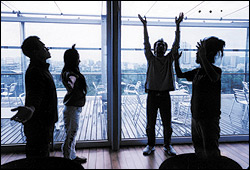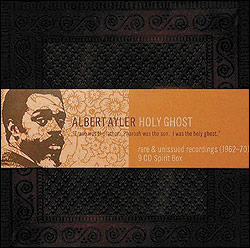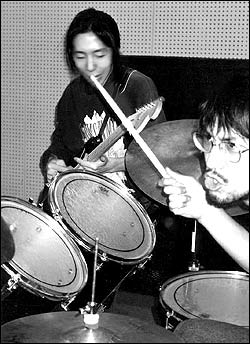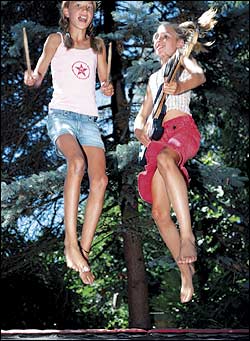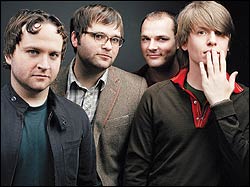The bizarre, monumental, high-concept Japanese band Boredoms used to explain that members who had stopped appearing with them onstage had “become invisible.” It’s not clear whether or not Boredoms themselves have become invisible now—according to some sources, they ended their 12-year career when guitarist Seiichi Yamamoto destroyed his guitar onstage at the Fuji Rock Festival in 1998 after the band played what he believed to be a perfect set. Any entity calling itself Boredoms now, according to this theory, should actually be referred to as V∞redoms, or perhaps 7 VO 7. The other argument is that Boredoms still exist as whatever rock band is led by the man who’s variously called himself Eye Yamatsuka, Yamantaka Eye, Yamataka Eye, and simply EYE; the appearance late last year of a new two-song album, Seadrum/House of Sun (WEA Japan), which Vice is issuing in the U.S. on May 10, seems to support that hypothesis.
“Seadrum” was recorded a few years ago, reportedly on a beach as the tide came in, with a battalion of drum kits, a marimba, and a piano on which somebody keeps sweeping up and down the keys for Alice Coltrane–ish arpeggios. It’s a spectacular piece of music, like a parade so long neither end can be seen. Once the drummers hit a peak a few minutes in, they stay there for around 20 minutes, with one jolting breakdown in the middle. What keep the song bound together are two voices, singing wordlessly and modally (one of them might be Eye, the other one appears to be drummer Yoshimi P-We, also of OOIOO—Boredoms-related bands seem to pick their names partly for how they look); what keeps the recording from becoming static is that the microphone sounds like it’s slowly moving around and between the drum kits and sometimes away from them to catch a little of the waves on the beach, like a camera doing a slow pan.
Still, Yamamoto may have had a point in wanting Boredoms to stop while they were ahead. The increasingly focused, overwhelming sequence of records the band made in the late ’90s (Super ae, Super Roots 7 and 8, and finally Vision Creation Newsun) pushed their rattling electric sun-worship-ritual aesthetic about as far as it could go. The next four Boredoms discs were the Rebore remix series, which juggled elements from the Super/Newsun sequence without adding too much to them; “Seadrum” often seems like a fractal close-up expansion of rhythms from Newsun, and the tingling sitar drones of the instrumental “House of Sun” recapitulate the final minutes of Super ae.
It’s not as if Eye is likely to run out of ideas—his 2000 mix CD Planetary Natural Love Gas Webbin’, assembled under the name DJ Pica Pica Pica, is one of the most flabbergasting and least predictable mixes ever released. But the same retracing-his-steps problem has turned up with another long-running collaboration of his. In the mid-’90s, Eye made a pair of nifty experimental albums with composer/saxophonist John Zorn: a noise-repetition freakout, Naninani, and an even stranger approximation of surface-noise-riddled wax-cylinder recordings of Jewish liturgical music, called Mystic Fugu Orchestra. (Eye had earlier sung, or rather screamed his lungs ragged, with Zorn’s precision death-jazz-core band Naked City on a few records.)
The Eye/Zorn duo has reunited for two new CDs. The studio set, recorded in 2003, is tellingly called Naninani II (Tzadik)—they’ve got a room full of instruments to play around with (steel guitar, banjo, Tibetan bells), as well as some squealing electronic devices, but all they seem willing to do is pick at them distractedly, approximating the improv experiments of the first Naninani without that album’s manic, devotional intensity. A live album, 5010 (Tzadik), recorded the same month at one of Zorn’s 50th birthday performances, is more energetic, but also more of a retread; with no opportunity to build up any kind of consistent rhythm or texture, Eye settles for shrieking and babbling like he was doing in the late ’80s, and Zorn pulls out his old noisemaking tricks, too (a video of part of the performance, included on the CD, shows Zorn blowing duck calls into a pitcher of water). The variety of squeaky noises on display is impressive, but we already knew they could do that.
Both albums have occasional flashes of the bold, sustained technique both Eye and Zorn have developed in the last 15 years. Zorn’s witty duck-and-weave saxophone playing on Naninani II‘s “4AB” has the verve of his jazz quartet Masada, and the same record’s “Shiso Baba” slowly filters Eye’s open-throated calls into a haze of organ and floorboard-creeping percussion. Unfortunately, both Eye and Zorn are essentially conceptualists—they’re not suited for totally free improv—and without an organizing principle for their duos, they’re each perpetually looking to the other for direction that’s not forthcoming.
On the live record’s “Sun See Soon,” their old Naked City bandmate Fred Frith joins them on guitar, and tries to boot them into action with a prolonged burst of noise—the sort of thing that both Eye and Zorn could blast off from if either one of them were running the show. But the energy of the piece’s opening rapidly dissolves into more scrapes, peeps, and gibbering. It’s as if the point of their collaboration has become “invisible,” too.
